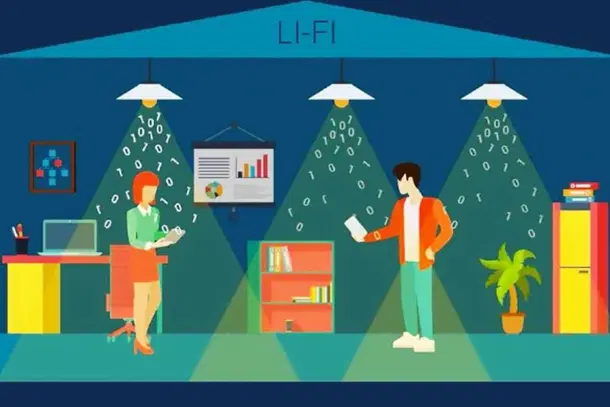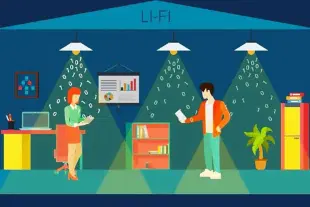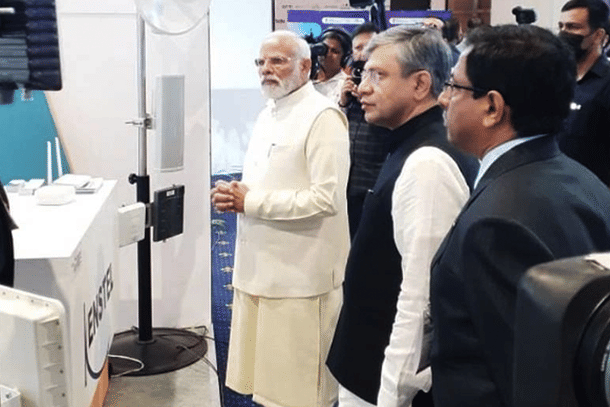Tech
Beyond Wi-Fi, It Could Be Li-Fi — And One Indian Player Is Already There
Anand Parthasarathy
Oct 11, 2022, 02:18 PM | Updated 04:43 PM IST
Save & read from anywhere!
Bookmark stories for easy access on any device or the Swarajya app.


The recently-concluded Indian Mobile Congress helped focus attention on a promising communication technology that many in the industry consider is an idea ahead of its time — but they could just be wrong: it may already be here.
Prime Minister Narendra Modi and Union IT and Industries Minister Ashwini Vaishnaw were among those who visited the stand of Ahmedabad-based Nav Wireless Technologies, the leading Indian and Asian player, working in the fast-emerging field of Li-Fi or Light Fidelity.

This seems to be a name cannily tailored to place it in competition with Wi-Fi (Wireless Fidelity), which is the established way today for lay users and enterprises alike, to wirelessly exchange data, especially over the Internet.
To quote Wikipedia, Li-Fi is a wireless communication technology which utilises light to transmit data and position between devices.
In technical terms, it is a light communication system that is capable of transmitting data at high speeds over the entire spectrum — visible light, ultraviolet, and infrared.
Right now, LED lamps are being used for the transmission of visible light. This could change as science evolves. The technology is similar to Wi-Fi, except that, one uses light waves, the other uses radio waves.
There are some obvious advantages: Wi-Fi gives rise to some electromagnetic interference, which might affect sensitive equipment — like the navigation system on aircraft or CT Scanners, MRO scanners and critical care equipment in hospitals.
That is why we are asked to keep our mobile phones switched off during flights and in some hospital areas like ICUs. Substitute radio waves with light waves and this particular problem vanishes.
Because it can travel at the speed of light, Li-Fi is potentially capable of much higher data rates than what is currently achievable by Wi-Fi systems — 10 times faster has already been achieved.
And the infrastructure required is not complex: it can use existing LED light fixtures and electricity lines with small additions.
Early Use Cases In India
Urban as well as rural reaches in its home state Gujarat have been early beneficiaries — and pioneering users — of this cutting-edge technology:
— In August 2020, at the height of the COVID-19 pandemic, Nay Wireless installed Li-Fi communication facilities in three government hospitals — the Civil Hospital (Ahmedabad), Surat Municipal Institute of Medical Education and Research (SMIMER) (Surat) and Gujarat Medical Education and Research Society (GMERS) Hospital, (Vadodara).
The LiFi-based centralised patient monitoring system at COVID-19 wards without any electromagnetic interference, ensured the safety of patients, doctors and the paramedical teams operating critical care equipment. It was a useful test of the technology in such sensitive environments.
— In February 2021, Nav Wireless set up a Li-Fi technology-based optical wireless communication system at Akrund and Navanagar villages in Dhansura tehsil, Aravalli district.
In just two days, the company deployed 10 gigabits per second (GBPS) Li-Fi lines to bridge the 1.5 km between the two villages. Schools, hospitals, post offices, and other government offices received this faster and safer Internet connection.
Last month, Nav Wireless announced that it has brought Li-Fi to students in Ladakh — working with the Students' Educational and Cultural Movement of Ladakh (SECMOL) and its charismatic founder Sonam Wangchuk.
The terrain in the area has posed a challenge for many schools and delayed the laying of conventional fibre optic data lines. Li-Fi’s wireless technology provided an elegant solution.
With decades of investment and vast swathes of infrastructure in place the world over, Wi-Fi is not going away any time soon.
But as Li-Fi proves itself in cases like these, where it provides a useful edge, light waves may play a useful complementary role with radio waves in providing the data networks of the future.
Suggests Hardik Soni, Nav Wireless Technologies founder and chief technology officer: “This Made-In-India technology can give India an edge over the existing technologies adopted by the developed nations.”
Li-Fi And 5G: Made For Each Other?
It might also emerge that Li-Fi and that other much-talked technology, 5G, may see common synergies:
Since 2019, leaders in wireless communication and lighting respectively, Vodafone Germany and Signify (a Philips company) have been quietly working together to explore and develop ways in which Li-Fi technology in local networks can be used in conjunction with 5G.
When that happens, India may be well poised to leverage this ‘made for each other’ combo: She has a significant head start in both technologies.
Anand Parthasarathy is managing director at Online India Tech Pvt Ltd and a veteran IT journalist who has written about the Indian technology landscape for more than 15 years for The Hindu.





